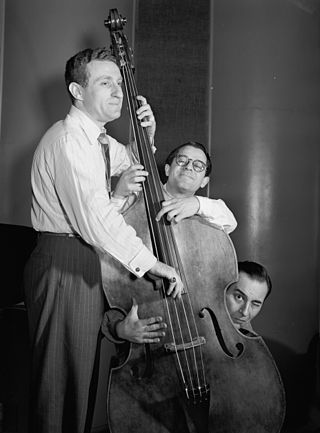
Adolphe Paul Barbarin was an American jazz drummer from New Orleans.

Albany Leon "Barney" Bigard was an American jazz clarinetist known for his 15-year tenure with Duke Ellington. He also played tenor saxophone.

Arthur James "Zutty" Singleton was an American jazz drummer.

Wilbur de Paris was a trombone player and band leader known for mixing Dixieland jazz with swing.

Quentin "Butter" Jackson was an American jazz trombonist.

Jack Lesberg was an American jazz double-bassist.

James "Trummy" Young was an American trombonist in the swing era. He established himself as a star during his 12 years performing with Louis Armstrong in Armstrong's All Stars. He had one hit with his version of "Margie", which he played and sang with Jimmie Lunceford's orchestra in 1937. During his years with Armstrong, Young modified his playing to fit Armstrong's approach to jazz.

Ella and Louis is a studio album by Ella Fitzgerald and Louis Armstrong, accompanied by the Oscar Peterson Quartet, released in October 1956. Having previously collaborated in the late 1940s for the Decca label, this was the first of three albums that Fitzgerald and Armstrong were to record together for Verve Records, later followed by 1957's Ella and Louis Again and 1959's Porgy and Bess.

William Edward Davison, nicknamed "Wild Bill", was an American jazz cornetist. He emerged in the 1920s through his work playing alongside Muggsy Spanier and Frank Teschemacher in a cover band where they played the music of Louis Armstrong, but he did not achieve wider recognition until the 1940s. He is best remembered for his association with bandleader Eddie Condon, with whom he worked and recorded from the mid-1940s until Condon's last concert at the New School for Social Research in New York in April 1972.

Johnny St. Cyr was an American jazz banjoist and guitarist. For banjo his by far most used type in records at least was the six string one. On a famous “action photo” with Jelly Roll Morton’s Red Hot Peppers he is holding a four string banjo, a Paramount Style A. There is, however, no verified information if he ever used such an instrument on records.
George "Little Mitch" Mitchell was an American jazz cornet player active in the 1920s.

John G. Blowers Jr. was an American drummer of the swing era. Born in Spartanburg, South Carolina, United States, Blowers ("Blau-ers") learned to play percussion during his schooldays and began performing with the Bob Pope Band in 1936. Blowers attended college at Oglethorpe College, now Oglethorpe University.
"Ain't Misbehavin'" is a 1929 stride jazz/early swing song. Andy Razaf wrote the lyrics to a score by Thomas "Fats" Waller and Harry Brooks for the Broadway musical comedy play Connie's Hot Chocolates.

Joe Darensbourg was an American, New Orleans–based jazz clarinetist and saxophonist, notable for his work with Buddy Petit, Jelly Roll Morton, Charlie Creath, Fate Marable, Andy Kirk, Kid Ory, Wingy Manone, Joe Liggins and Louis Armstrong.

Barrett Deems was an American swing drummer from Springfield, Illinois. He worked in bands led by Louis Armstrong, Jimmy Dorsey, Red Norvo, and Muggsy Spanier.
"Them There Eyes" is a jazz song written by Maceo Pinkard, Doris Tauber, and William Tracey that was published in 1930. One of the early recorded versions was performed by Louis Armstrong in 1931. It was made famous by Billie Holiday, who recorded her version in 1939 for Vocalion Records.

Claude Jones was an American jazz trombonist.

James Preston McDonald, better known by his stage name Preston Jackson was an American jazz trombonist.

The Nice Jazz Festival, held annually since 1948 in Nice, on the French Riviera, is "the first jazz festival of international significance." At the inaugural festival, Louis Armstrong and his All Stars were the headliners. Frommer's calls it "the biggest, flashiest, and most prestigious jazz festival in Europe." From 1974 it was known as La Grande Parade du Jazz; in 1980 the name changed to JVC Nice Jazz Festival; since 1993 it has been known as the Nice Jazz Festival.
Joe "Fox" Smith was an American jazz trumpeter.














